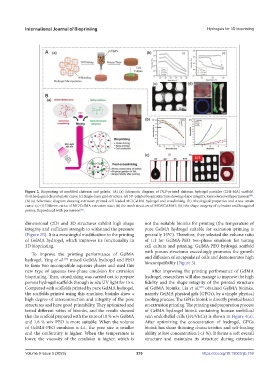Page 224 - IJB-9-5
P. 224
International Journal of Bioprinting Hydrogels for 3D bioprinting
Figure 2. Bioprinting of modified chitosan and gelatin. (A) (a) Schematic diagram of DLP-printed chitosan hydrogel particles (CHI-MA) scaffold.
[88]
(b) Rheological characteristic curve. (c) Single-layer grid structure. (d) 3D-printed bionic structure showing shape integrity. Reproduced with permission .
(B) (a) Schematic diagram showing extrusion-printed cell-loaded MC/GelMA hydrogel and crosslinking. (b) Rheological properties and stress–strain
curve. (c) (i) Different ratios of MC/GelMA extrusion state; (ii) the mesh structure of MC8/GelMA5; (iii) the shape integrity of cylinders and hexagonal
[22]
prisms. Reproduced with permission .
dimensional (2D) and 3D structures exhibit high shape not the suitable bioinks for printing (the temperature of
integrity and sufficient strength to withstand the pressure pure GelMA hydrogel suitable for extrusion printing is
(Figure 2B). It is a meaningful modification to the printing generally 15°C). Therefore, they selected the volume ratio
of GelMA hydrogel, which improves its functionality in of 1:1 for GelMA-PEO two-phase emulsion for testing
3D bioprinting. cell culture and printing. GelMA-PEO hydrogel scaffold
To improve the printing performance of GelMA with porous structures exceedingly promotes the growth
hydrogel, Ying et al. mixed GelMA hydrogel and PEO and diffusion of encapsulated cells and demonstrates high
[35]
to form two incompatible aqueous phases and used this biocompatibility (Figure 3).
new type of aqueous two-phase emulsion for extrusion After improving the printing performance of GelMA
bioprinting. Then, crosslinking was carried out to prepare hydrogel, researchers will also manage to improve the high
porous hydrogel scaffolds through in situ UV light for 15 s. fidelity and the shape integrity of the printed structure
Compared with scaffolds printed by pure GelMA hydrogel, of GelMA bioinks. Liu et al. obtained GelMA bioinks,
[85]
the scaffolds printed using this emulsion bioinks show a namely GelMA physical gels (GPGs), by a simple physical
high degree of interconnection and integrity of the pore cooling process. The GPGs bioink is directly printed based
structures and have good printability. They optimized and on extrusion printing. The printing and preparation process
tested different ratios of bioinks, and the results showed of GelMA hydrogel bioink containing human umbilical
that the scaffold prepared with the ratio of 10 % w/v GelMA vein endothelial cells (HUVECs) is shown in Figure 4(a).
and 1.6 % w/v PEO is more suitable. When the volume After optimizing the concentration of hydrogel, GPGs
of GelMA-PEO emulsion is 4:1, the pore size is smaller bioink has shear thinning characteristics and self-healing
and the uniformity is higher. When the temperature is ability at low concentration (<3 %). It forms a soft overall
lower, the viscosity of the emulsion is higher, which is structure and maintains its structure during extrusion
Volume 9 Issue 5 (2023) 216 https://doi.org/10.18063/ijb.759

